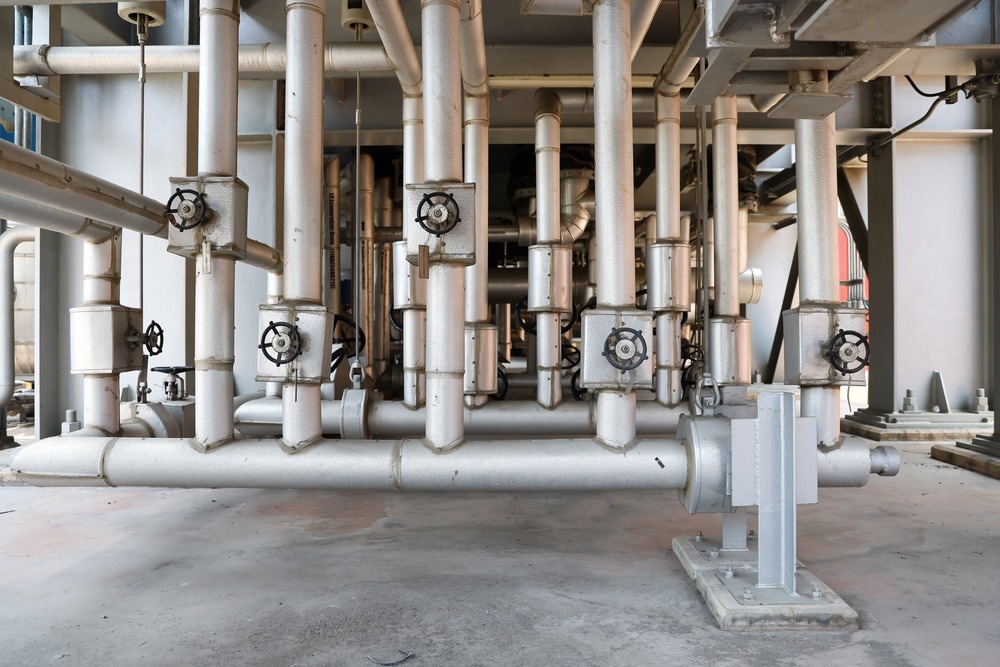In this interview, we explore the fundamentals of thermal fluid systems, the importance of fluid selection, and the impact of proper maintenance on system performance and safety. We also uncover common pitfalls, including the risks associated with using imposter fluids, and provide expert guidance on identifying and selecting the right heat transfer oils.
What are thermal fluids, and what are some advantages and drawbacks of using thermal fluids?
Thermal fluids, also known as heat transfer fluids, are also referred to as hot oils, thermal oils, or thermic oils, depending on the industry, location, or region of the world. These terms are often used interchangeably to describe the same technology.

Image Credit: Nutthapat Matphongtavorn/ShutterStock.com
The main advantage of thermal fluids is their ability to generate high operating system temperatures without creating significant pressure. Increased pressure introduces complications to operations, reduces safety margins, and requires more maintenance. By minimizing pressure, thermal fluid systems offer a safer and more efficient alternative.
One drawback is that thermal fluid systems are generally low-maintenance and often operate as a "set it and forget it" system. Because of this, they can sometimes be taken for granted, leading to potential issues if problems arise and go unnoticed.
Can you explain the basics of a thermal fluid system?
A thermal fluid system, specifically a circulating closed-loop thermal fluid system, operates as a secondary type of heating. The process begins with heating the thermal or heat transfer fluid in a heat source. The heat source transfers energy into the fluid, which is then piped and pumped into a system that controls the temperature of the process user.
The process user depends on the industry and can refer to any component requiring temperature control, whether for heating or chilling. The number of process users can vary based on the system design. Depending on the setup, there could be one, 12, or any number.
Why is fluid selection so important in preventing operational issues?
Fluid selection is an important part of system efficiency. We are not talking about brands of fluid but rather the right design for a purposefully intended heat transfer fluid. Using the wrong fluid will likely lead to premature, accelerated degradation, increasing the potential for equipment failures.
When the fluid degrades, breaks down, and fouls the surface of the equipment, it results in increased maintenance. Changes in the fluid's physical properties lead to decreased efficiency, which can create a downward spiral of problems. If these issues go unchecked when they first arise, they can cause significant operational challenges in the long run.
How does proper system operation impact safety?
Safety is always the primary consideration. When a properly designed system is operated correctly with the appropriate fluid, it is inherently safer. It requires less maintenance than other well-known technologies, such as direct heat or steam. However, because these are high-temperature operations, any negligence or failure to follow proper procedures will exponentially increase the inherent dangers.

Image Credit: Travel mania/ShutterStock.com
Why is thermal stability important in a heat transfer fluid?
Thermal stability is a critical factor that sets these fluids apart from other industrial fluids. A thermally stable fluid must withstand the stress of thermal energy transfer without breaking down.
If the fluid degrades under stress, it can foul the system, cause damage to equipment, increase maintenance requirements, and lead to unplanned downtime. A less stable fluid will accelerate this process, creating a downward spiral of operational issues.
What are the consequences of using a poorly purified heat transfer fluid?
An inferior purified product will retain more impurities, meaning degradation begins accelerated. As these contaminants break down, they foul the equipment surfaces, further reducing efficiency. Since these systems operate at high temperatures, any remaining contaminants can create significant long-term issues.
One simple way to monitor purity, especially for mineral oil-based products, is by observing the color of the fluid. Color changes can indicate contamination or degradation. We will go into more detail about this when discussing the red flags associated with impurities.
What do you mean by "imposter fluids" in heat transfer systems?
An imposter fluid is any fluid marketed and sold as a heat transfer fluid but not purposefully designed for that application. It might come in a drum with a label stating "heat transfer fluid," have supporting literature, and even be recommended by a salesperson. While it may legally be used in a heat transfer system, it lacks the stability, purity, and efficiency required to protect equipment and optimize performance.
What red flags indicate a fluid might not be a true heat transfer fluid?
You should avoid fluids labeled as "multipurpose fluid", "lubricating oil", "industrial fluids", "hydraulic fluids", "transformer oils", "quenching fluids", "turbine fluids", or "petroleum lubricants".
These terms indicate that the fluid is designed for other industrial applications and lacks the specialized properties required for effective heat transfer. Many large distributors and manufacturers produce a variety of industrial oils, making it easy to mistakenly choose an imposter fluid.

Image Credit: ARTFULLY PHOTOGRAPGER/ShutterStock.com
How can someone ensure they select the correct heat transfer oil lubricant when the drum label does not explicitly state it?
The key is not to be misled by marketing tactics or product branding. The drum label may contain branding, and the company’s website or engineering bulletins may only provide basic product data. You need to take an extra step to select the correct product. Check the Safety Data Sheet (SDS) for the specific product.
The SDS typically provides more detailed information about the product than what is found on the label or in marketing materials. For example, the product name is usually listed at the top of the SDS, such as "Thermal Fluid 123 XYZ" or "Hi-Pertherm Heat Transfer Oil 26".
To take it further, section one of the SDS - under identification - often reveals critical information. This is where red flags may appear, particularly in the application description.

This information has been sourced, reviewed and adapted from materials provided by The Lubrizol Corporation.
For more information on this source, please visit The Lubrizol Corporation.
Disclaimer: The views expressed here are those of the interviewee and do not necessarily represent the views of AZoM.com Limited (T/A) AZoNetwork, the owner and operator of this website. This disclaimer forms part of the Terms and Conditions of use of this website.